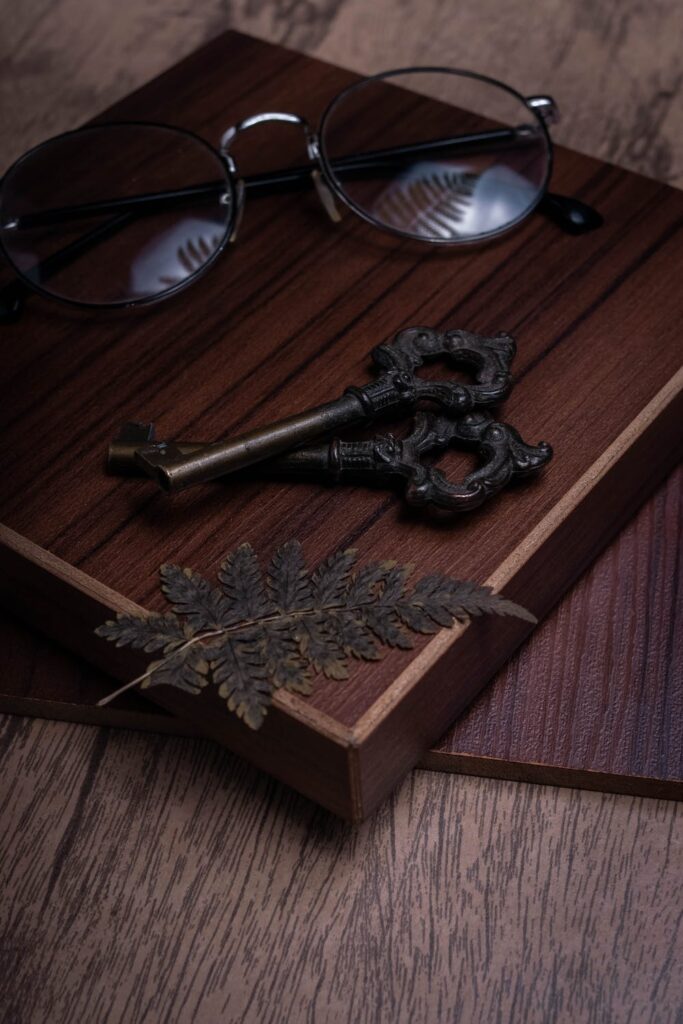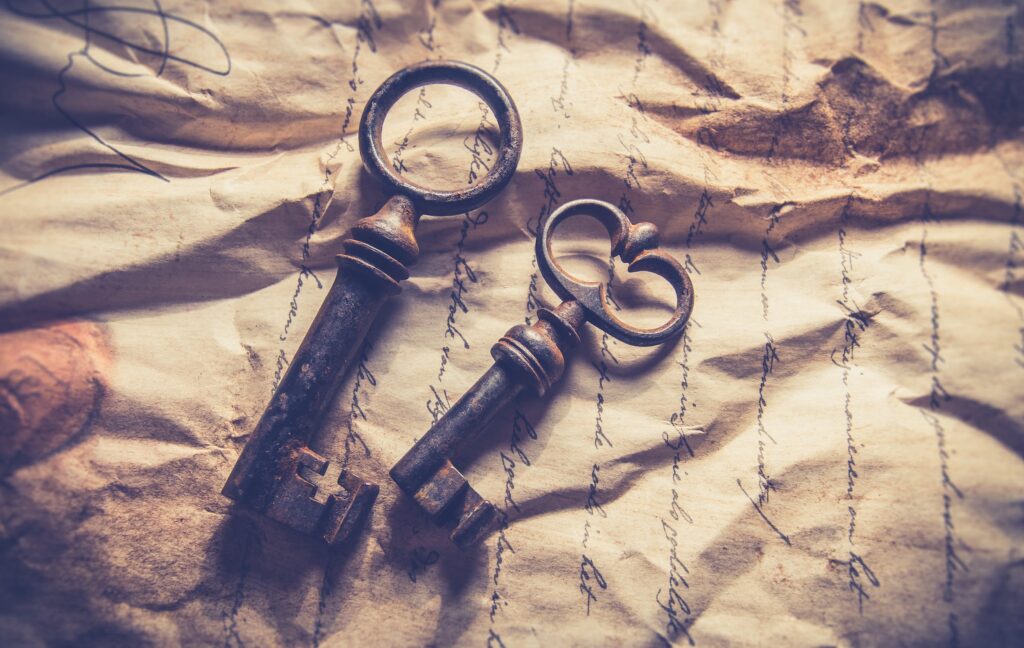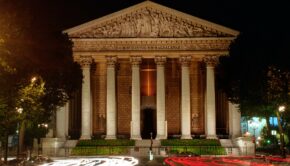The Bastille Key at Mount Vernon, the Historic Home of George Washington
While visiting friends that had moved to Washington D.C., on the top of our tourist list was a visit to Mount Vernon, Virginia. Having lived on the West Coast of the United States for most of my life, I was only familiar with U.S. colonial history from what I had read in history books, had seen in movies or had studied in school. To be able to see the real historical sites was truly inspiring.
While touring the grounds and estate of Mount Vernon, the former of home the first president of the United States, George Washington, I was surprised to find a connection to France on display in the central passage of the estate house. Right before my eyes, encased in a glass display, hanging on the wall of President George Washington’s former home was the original key to the Bastille. I was fascinated to see this and was curious as to how this historical French item came to rest in Mount Vernon, Virginia. Of additional interest was the Lafayette Bedchamber, a bedroom designated for the Marquis de Lafayette that also displayed his portrait. Obviously the two were connected, but at that time I did not know how or why.

https://www.pexels.com/photo/eyeglasses-and-old-fashioned-key-near-dried-plant-8364558/
George Washington acquired Mount Vernon in 1761 from his half-brother, who had inherited it from his father, Augustine Washington. During George’s 45 years of living at Mount Vernon, he continually constructed and remodeled the estate, expanding it to 21 rooms; this is the same structure that we see today. George Washington is the only U.S. President who never lived in the White House, as its construction was not completed before his death. He spent his time in Philadelphia, which was where the government resided prior to moving to Washington D.C., and at his home at Mount Vernon.
Marie Joseph Paul Yves Roch Gilbert du Motier, also known as the Marquis de Lafayette, was born in 1757. He was a member of one of France’s oldest families; his family history includes ancestors that served in the Crusades with Joan of Arc. When Gilbert was 2 years old, his father was killed while fighting in the Seven Years’ War. When he was 11 years old, his mother died and then he inherited one of France’s largest fortunes. Lafayette was appointed to the Black Musketeers after winning a captain’s commission in the French Army in 1771; he was only 14 years old. At age 16 he married a woman who also came from great wealth and societal stature, Marie de Noailles.
In 1775, when the government reduced its military spending, Lafayette lost his commission. Later, while attending a dinner in the city of Metz, he met the Duke of Gloucester, the brother of British King George III. The dinner conversation between the men focused on the American colonists who were rising up against British rule. The colonial revolutionaries desired to govern themselves, and no longer wished to be under British authority. In his memoirs, Lafayette wrote: “My heart was enlisted and I thought only of joining my colors to those of the revolutionaries.” He studied all characteristics of the American Revolution and planned to enlist in the Continental Army that had been organized by the colonists under the rule of George Washington.
Sent to France to recruit officers, Silas Dean, a representative of the Continental Congress, offered Lafayette a commission, even though he was only 19 years old and had no war experience. Louis XVI ordered him not to leave France, but Lafayette disobeyed the king’s orders and set sail for the new world in early 1777. Upon his arrival in Philadelphia, Congressman James Lovell of Massachusetts, realizing that Lafayette was not just an ordinary person but seeing that he came from great wealth and was very well-connected, recommended Lafayette’s appointment as Major General in the Continental Army. Interestingly, Lafayette served in the Continental Army as a volunteer and with no pay; two conditions of his enlistment. This was not an army that had the luxury of ample funding; Lafayette paid his own way and purchased supplies for himself and many of the men that served under him.
The Marquis de Lafayette and George Washington met in the summer of 1777; the two men formed an instant bond. Lafayette was 19 years old, Washington was 45. In September 1777, Lafayette joined General George Washington’s army camp on the banks of the Brandywine Creek, south of Philadelphia. Washington assigned Lafayette to join General John Sullivan’s forces that were in a miserable fight with the British Redcoats; the Redcoats were trying to surround Washington and his men. General Sullivan was forced to retreat and during this retreat, Lafayette was shot in the leg. George Washington, highly concerned with the injuries that Lafayette had sustained, sent his own surgeon to care for Lafayette instructing the doctor to “treat him as if he were my son”. Since George Washington never had any children of his own, this was a special honor and showed the depth of their friendship. This close friendship would last until Washington’s death in 1799.
The winter of 1777 – 1778 was spent at Valley Forge. During this time Lafayette worked endlessly to obtain support from France to aid the American Revolution. It was in early 1778 that the French alliance arrived in order to support the revolutionary efforts against British rule.
In 1781, the last major battle of the American Revolution took place in Yorktown, Virginia. As commander of the Virginia Continental forces, Lafayette and his men were able to keep British Lieutenant General Lord Cornwallis and his army at Yorktown. Meanwhile, George Washington and his troops, along with Comte de Rochambeau of France, surrounded the British and forced their surrender.
After the American Revolution, Lafayette and Washington continued their close friendship. At the end of 1781, Lafayette returned to France and rejoined the French army. Part of his duties was to establish trade agreements between the newly freed colonies and France. For this task, he worked closely with Thomas Jefferson, who at that time was the American ambassador to France.
Washington and Lafayette maintained regular correspondence, keeping their friendship and respect for one another ever stronger. In a letter dated from 1784 written to the Marquis, George Washington writes “It is unnecessary, I persuade myself to repeat to you my Dear Marquis the sincerity of my regards and friendship, nor have I words which could express my affection for you, were I to attempt it.” As a strong reflection to their friendship, Lafayette named his eldest son Georges Washington de Lafayette, after his dear friend.
In the next few years, political and social turmoil were rising in France. Lafayette was in favor of the governing body that represented the three social classes; he also wrote the Declaration of the Rights of Man and Citizen. After obtaining extensive military experience in the American Revolution, he had been appointed the title of Commander of the Paris National Guard. On July 14, 1789, after the Bastille was stormed by an angry mob, the keys to the Bastille were handed to Lafayette. The Bastille was a symbol of royal repression, not only a prison. The people of France, by revolting against the Bastille, were actually rising up against the direct repression of the monarchy. In March of 1790 Lafayette, being optimistic about the uprising, similarly as he had been with the American Revolutionaries against the British rule, shipped the Bastille key and a drawing of the demolished prison to George Washington, on behalf of the people of France. It was first carried by Thomas Paine and then transferred to John Rutledge, Jr., who was returning to the United States from London. After being received by George Washington, he had a custom-made gilded case created in order to properly display the key, not only as a gift from a beloved friend, but also as an important symbolic representation of freedom, as a “token of victory by Liberty over Despotism.”
The key was first displayed at a presidential reception in New York in August 1790. The seat of the government moved to Philadelphia in the fall of 1790 and the key was on display in Philadelphia until 1797 when it was relocated to Mount Vernon. George Washington was retiring to his beloved estate and the key was given a place of honor in the first floor central passageway at Mount Vernon where it is still on display.
The Marquis de Lafayette returned to the United States in 1794; he stayed at Mount Vernon for 10 days while visiting George Washington and his family. Lafayette, this time with his son, again visited Mount Vernon in 1824 during a year-long tour of the United States. There, in the central passageway, as it had hung for many years, was the key to the Bastille. For Lafayette this was possibly an emotional reflection of war and freedom, for both the United States and for France.

https://www.pexels.com/photo/two-black-skeleton-keys-on-an-old-paper-612800/
The Marquis de Lafayette died of pneumonia on May 20, 1834, and is buried in the Picpus Cemetery in Paris. When the news of his death reached the shores of America, parts of the nation went into mourning. President Andrew Jackson ordered that the Marquis de Lafayette shall receive the same funeral honors that George Washington had received during his services. John Quincy Adams gave a three-hour long eulogy in Congress in which he stated: “The name of Lafayette shall stand enrolled upon the annals of our race high on the list of the pure and disinterested benefactors of mankind.” Lafayette’s grave was sprinkled with earth from the United States and an American flag was also displayed next to his gravesite.
The Marquis de Lafayette is considered a hero of the American Revolution. Lafayette was given honorary United States citizenship in 2002, and is known as “The Hero of Two Worlds.” No person of a foreign country had ever deserved and received the level of esteem, respect and appreciation that was given to the Marquis de Lafayette. Without the assistance of Lafayette and the French Army, the United States would be a very different place, and possibly not even exist, as it does today.





















Wonderful article, as read on 14 July.
Very well written.
Great article. It brings light to a fact that eludes most Americans…the great importance that the French had in our breaking away from being a dependent country teething on Great Britain’s hind tit. It is truly a shame how little importance this is given in our educational system and how much more important it should be remembered today and in the future. Let’s keep the 2nd amendment.
Au cours de la visite de ce magnifique endroit,quelle fut notre surprise de constater que le tableau fixé au bas de l’escalier et offert par La Fayette,est signé d’un certain Cathala donc d’un homonyme !..Détail amusant : ayant demandé au gardien la permission de photographier ce tableau en lui montrant ma carte d’identité,il fit écarter les visiteurs présents vraiment comme pour une haute personnalité.Nous nous sentions assez fiers…..J’ai oublié la qualité qui suit la signature,mais il me semble que le personnage avait un rôle important.C’est invisible sur la photo.
Thanks! For more information about the Bastille Key, check out http://www.bahrnoproducts.com/Bastille_Key.htm